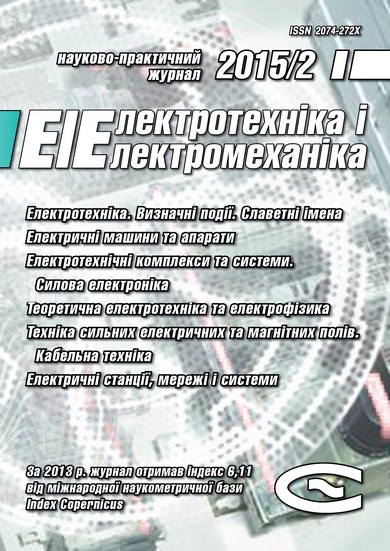AN ANALYSIS OF THE ELECTROMAGNETIC PROCESSES IN THE INDUCTOR SYSTEM – TOOL OF THE STRAIGHTENING OF CAR BODIES
DOI:
https://doi.org/10.20998/2074-272X.2015.2.10Keywords:
electromagnetic process, inductor, attracting screen, additional coil, attracting forcesAbstract
Introduction. One of the promising directions of electromagnetic forming (EMF) is a contactless magnetic-pulse straightening of the automobile bodies. The efficiency and the quality of the straightening depend on design and operating principle of the straightening tool. In the modern technique of EMF a large number of the tools - inductor systems (IS) is used in different configurations with uneven distribution forces on the treatment object that in turn does not meet the needs of the effective process of straightening. There appears the urgent necessity to create IS with high uniformity of the induced field and a high concentration of attracting forces in the working area of the tool. The most effective IS are the Inductor Systems with an Attracting Screen (ISAS). One of the most important considerations when choosing a particular design ISAS is the study of the electrodynamics processes with definition of excited loads. The nature and the course of the electrodynamics processes in accordance with design features determine the effectiveness and the efficiency of the ISAS. Therefore, in ISAS an additional coil for the concentration of the attracting forces in the working area should be entered. Purpose. The numerical analysis of the induced fields and the currents in the experimental models of ISAS with an additional coil was made. Methodology. In the idealization of the «extremely low» frequencies of existing fields, there were received rated dependences for density of the induced currents and distributed attracting force in ISAS and the external additional coil, through the use of the calculated model in the cylindrical coordinate system. Results. Insertion of the additional coil placed over the accessory screen allows to concentrate and increase the amplitude of the attracting forces in the central part of the working area of the inductor system. Practical value. 1. Numerical analysis of fields and currents in experimental models of Induction Systems with Attracting Screen (ISAS) and additional coil, designed to align the metal coatings of vehicles was made. 2. It is shown that if in ISAS they insert additional coil placed over the accessory screen significantly increases the amplitude of excited forces of attraction. 3. It is shown that the parallel connection of the primary and additional coils in ISAS allows to concentrate the forces of attraction in the centre of the working area of the tool for straightening automobile bodies.References
Gnatov A.V., Batygin Yu.V., Chaplygin E.A. Impul'snye magnitnye polya dlya progressivnyh tehnologij. Magnitno-impul'snye tehnologii beskontaktnoj rihtovki kuzovnyh elementov avtomobilya: monografіya [Pulsed magnetic fields for advanced technologies. Magnetic pulse contactless technology straightening car body elements. Monograph]. Saarbryukken, LAP LAMBERT Academic Publ., 2012. 242 p. (Rus).
Turenko A.N., Batygin Yu.V., Gnatov A.V. Impulsnyie magnitnyie polya dlya progressivnyih tehnologiy. Tom 3. Teoriia i eksperiment pritiazheniia tonkostennykh metallov impul'snymi magnitnymi poliami [Pulsed magnetic fields for advanced technologies. Vol. 3. Theory and experiment of thin-walled metals attraction by the pulse magnetic fields]. Kharkov, KhNAHU Publ., 2009, 240 p. (Rus).
Batygin Yu.V., Bondarenko A.Yu., Chaplygin E.A. Cylindrical induction inductor system for attraction of thin-walled sheet metal. Aviacionno-kosmicheskaya tehnika i tehnologiya – Aerospace Engineering and Technology, 2007, no.11(47), pp. 109-117. (Rus).
Batygin Yu.V., Gnatov A.V., Chaplygin Y.A., Gopko A.V., Shigoleva S.A., Drobinin A.M. Sposib magnitno-impul'snogo prytjagannja metalevyh ob’jektiv dvovytkovoju krugovoju induktornoju systemoju z tonkym ekranom [The method of magnetic-pulse attraction of metal objects by double-turn circular inductor system with a thin screen]. Patent UA, no.70734, 2012. (Ukr).
Batygіn Yu.V., Gnatov A.V., Chaplygіn E.O., Trunova І.S., Gopko A.V., Sabokar O.S. Sposіb magnіtno-іmpul'snogo prityagannya metalevih zagotіvok odnovitkovim krugovim іnduktorom, roztashovanim nad dopomіzhnim ekranom [Method of the magnetic-pulse attraction metal workpeaces single-turn circular inductor located on the auxiliary screen]. Patent UA, no.77579, 2013. (Ukr).
Batygin Yu.V., Gnatov A.V., Argun Sh.V., Yeryomina E.F. Electromagnetic processes in symmetric induction systems with identical ferromagnetic thin-walled screen and sheet blank. Elektrotekhnika i elektromekhanika – Electrical engineering & electromechanics, 2012, no.4, pp. 50-53. (Rus).
Batygin Yu.V., Chaplygin E.A., Shinderuk S.A. Calculation of fields and currents in the induction system with the attractive screen and the additional coil as a tool for the straightening. Elektrotekhnika i elektromekhanika – Electrical engineering & electromechanics, 2015, no.1, pp. 57-62. (Rus).
Belyj I.V., Fertik S.M., Himenko L.T. Spravochnik po magnitno-impulsnoj obrabotke metallov [Directory of magnetic-pulse treatment of metals]. Kharkiv, Vishcha shkola Publ., 1977, 189 p. (Rus). (Rus).
Batygin Yu.V., Lavіns'kij V.І., Havіn V.L. Sposіb magnіtno-іmpul'snoyi obrobki tonkostіnnih metalevih zagotovok [Method of the magnetic-pulse processing thin metal work pieces]. Patent UA, no.74909, 2006. (Ukr).
Neyman L.R., Demirchyan K.S. Teoreticheskie osnovy elektrotekhniki. V 2-kh t. T. 2 [Theoretical bases of electrical engineering. In 2 vols. Vol. 2]. Leningrad, Energiya Publ., 1967, p. 340. (Rus).
Downloads
Published
How to Cite
Issue
Section
License
Copyright (c) 2015 Yu. V. Batygin, E. A. Chaplygin, S. A. Shinderuk

This work is licensed under a Creative Commons Attribution-NonCommercial 4.0 International License.
Authors who publish with this journal agree to the following terms:
1. Authors retain copyright and grant the journal right of first publication with the work simultaneously licensed under a Creative Commons Attribution License that allows others to share the work with an acknowledgement of the work's authorship and initial publication in this journal.
2. Authors are able to enter into separate, additional contractual arrangements for the non-exclusive distribution of the journal's published version of the work (e.g., post it to an institutional repository or publish it in a book), with an acknowledgement of its initial publication in this journal.
3. Authors are permitted and encouraged to post their work online (e.g., in institutional repositories or on their website) prior to and during the submission process, as it can lead to productive exchanges, as well as earlier and greater citation of published work.





